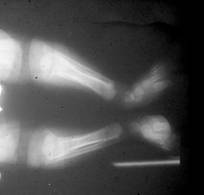Intrauterine (Congenital) Infections
Congenital infections are usually acquired by transplacental entry of the organism from the mother's bloodstream into the fetus, though infection may also occur during passage through the birth canal. The acronym TORCH is commonly used to list infections caused by Toxoplasmosis, Other (syphilis, varicella zoster, parvovirus) Rubella, Cytomegalovirus and Herpes simplex.
Transplacentally acquired infections may result in fetal loss, intrauterine growth retardation, prematurity, or postnatal disease. Following birth, congenitally acquired infections may present as central nervous system abnormalities such as microcephaly; hepatosplenomegaly with abnormal liver function tests, and thrombocytopenia. Each of the infecting agents also produces its own characteristic clinical features:
Toxoplasmosis: chorioretinitis, obstructive hydrocephalus, mental retardation, intracranial calcification, and convulsions. The infection may not be obvious at birth.
Syphilis: hepatosplenomegaly, nasal discharge or "sniffles", anemia, thrombocytopenia, mucocutaneous rash, periosteitis, osteochondritis, nephrotic syndrome, and central nervous system abnormalities.
|
Syphilis with Periostitis |
Rubella: hepatosplenomegaly, growth retardation, thrombocytopenia, petechiae, "blueberry muffin" lesions. Late features include deafness, cataracts, and mental retardation.
Cytomegalovirus: CNS abnormalities, hepatosplenomegaly, and intracranial calcifications. Deafness in later life is an important complication and may be the only clinical manifestation.
Herpes simplex: vesicles, encephalitis, or disseminated infection with multi-organ failure. Congenital herpes simplex is a medical emergency. Most neonate infections due to herpes simplex are not present at birth. Rather, the disease is acquired by direct contact during delivery to a mother who is infected. The incubation period is about 5 to 10 days and the baby presents with cutaneous lesions and/or systemic signs and symptoms suggesting sepsis.
|
Herpes Vesicles |
Human immunodeficiency virus: HIV infection may be acquired transplacentally, by exposure to blood during delivery, or via breast milk. Infection occurs in approximately 25% of the exposed children. Medication and careful perinatal management reduces the transmission rate in the US to about 2%. Treatment of the mother and subsequently the child with zidovudine significantly reduces the risk of infection.
Parvovirus B19 infection in the fetus can cause intrauterine anemia leading to congestive cardiac failure and hydrops fetalis. Varicella zoster infection may lead to cutaneous scarring, atrophy of the extremities, microcephaly, mental retardation, cataracts, and abnormalities of bladder and bowel function.
Quickcheck: Intrauterine (congenital) Infections
Please answer the questions true or false.






